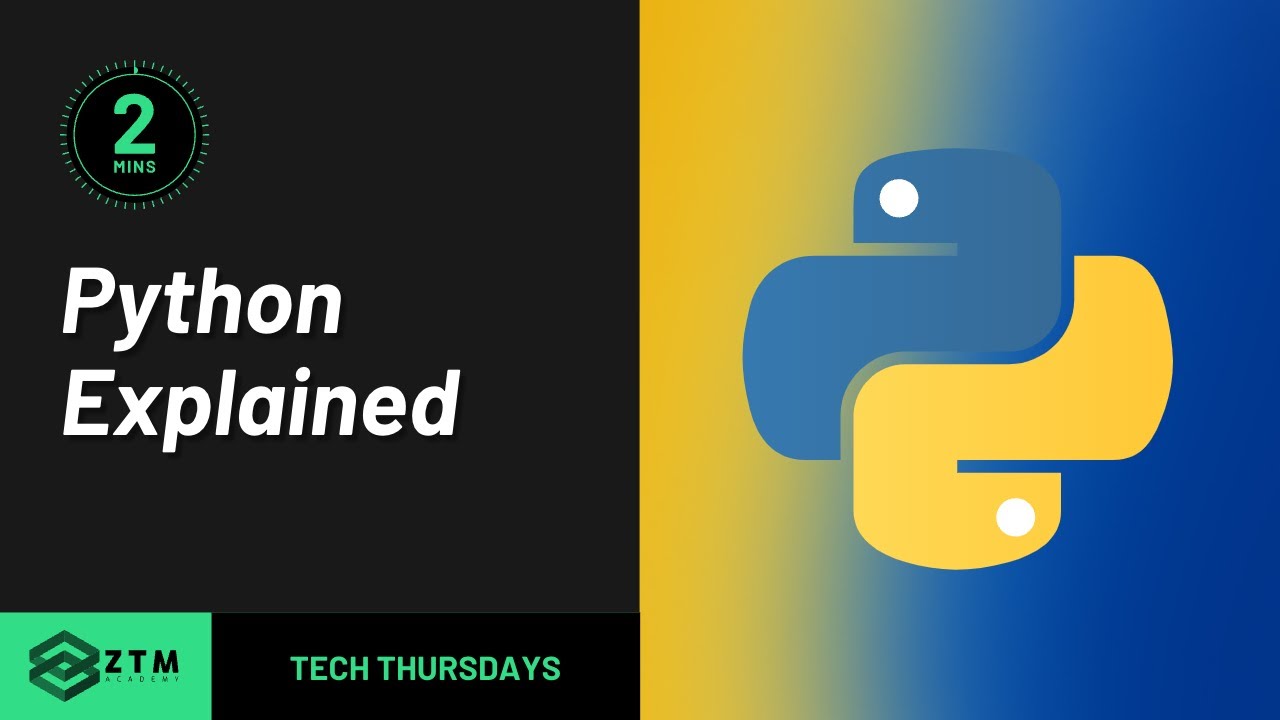Python in 100 Seconds
Summary
TLDRPython, a high-level interpreted programming language, is renowned for its simplicity and readability, making it a top choice for beginners and professionals alike. Created by Guido van Rossum in 1991, it's extensively used for web applications, big data analysis, and machine learning. Python's dynamic typing and emphasis on explicitness over magic ensure code clarity. With a strong ecosystem of libraries, it supports multiple programming paradigms and is easily managed with tools like Jupyter notebooks and the PIP package manager.
Takeaways
- 🐍 Python is a high-level, interpreted programming language known for its readability and ease of learning.
- 🌐 It's widely used for building server-side applications and is popular for web development with frameworks like Django.
- 📊 Python is the go-to language for Big Data analysis and machine learning, supporting various libraries and frameworks.
- 🎓 Many students start learning to code with Python due to its emphasis on readability and straightforward syntax.
- 📝 Python's philosophy, as outlined by 'The Zen of Python,' prioritizes simplicity and explicitness over clever tricks.
- 🔍 The language is dynamic and strongly typed, allowing for flexibility without sacrificing type safety.
- 📚 Code is often organized into notebooks, where cells can be executed and documented in the same place.
- 💻 Python is at version 3, with .py or .ipynb files used for scripting and interactive notebooks, respectively.
- 🛠️ It supports multiple programming paradigms, including functional programming with lambda functions and object-oriented programming with classes and inheritance.
- 🌟 Python boasts a vast ecosystem with third-party libraries like TensorFlow for machine learning and OpenCV for computer vision, often installed via pip.
- 👍 The video encourages viewers to like for more short, informative videos on programming languages.
Q & A
What makes Python a popular programming language?
-Python is popular due to its ease of learning and practicality for serious projects. It emphasizes readability and has a large ecosystem of third-party libraries.
Who created Python and in which year was it released?
-Python was created by Guido van Rossum and released in 1991.
What is the origin of the name 'Python' for the programming language?
-The name 'Python' was inspired by Monty Python's Flying Circus, hence the occasional use of spaming eggs instead of Foo and bar in code samples.
What are some common applications of Python?
-Python is commonly used to build server-side applications, web apps, and is the language of choice for Big Data analysis and machine learning.
Why is Python often chosen by students to start learning to code?
-Python is chosen by many students for its emphasis on readability, as outlined by the Zen of Python, which states 'beautiful is better than ugly' and 'explicit is better than implicit'.
What is the significance of the Zen of Python in the language's design?
-The Zen of Python guides the language's design philosophy, advocating for simplicity and readability, avoiding the temptation to sprinkle in magic that causes ambiguity.
How is Python's syntax designed to be efficient?
-Python's syntax is designed to be highly efficient, allowing the declaration of multiple variables on a single line and the definition of tuples, lists, and dictionaries with literal syntax.
What is the role of indentation in Python code?
-Indentation in Python is used to terminate or determine the scope of a line of code, eliminating the need for curly braces and semicolons found in many other languages.
How does Python support different programming paradigms?
-Python is a multiparadigm language, supporting functional programming patterns with features like lambda functions, and object-oriented patterns with classes and inheritance.
What is the significance of the 'def' keyword in Python?
-The 'def' keyword in Python is used to define a function, followed by an indented block of code that constitutes the function body.
How do you create a variable in Python?
-In Python, you create a variable by setting a name equal to a value. Python is strongly typed, ensuring values don't change unexpectedly, but dynamic, so type annotations are not required.
Outlines

This section is available to paid users only. Please upgrade to access this part.
Upgrade NowMindmap

This section is available to paid users only. Please upgrade to access this part.
Upgrade NowKeywords

This section is available to paid users only. Please upgrade to access this part.
Upgrade NowHighlights

This section is available to paid users only. Please upgrade to access this part.
Upgrade NowTranscripts

This section is available to paid users only. Please upgrade to access this part.
Upgrade Now5.0 / 5 (0 votes)





